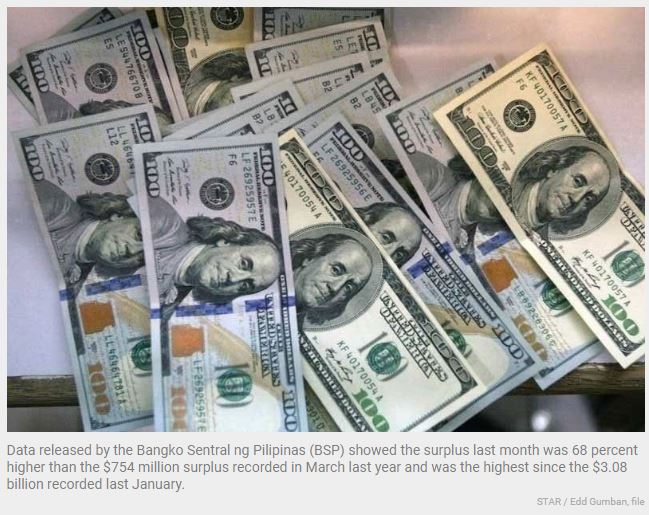Philippines: BOP surplus widens to $1.27 billion in March
MANILA, Philippines — The country’s balance of payments (BOP) position reverted to a surplus of $1.27 billion in March, reversing the $895-million deficit in February on the back of strong inflows from loans obtained by the national government from multilateral lenders.
Data released by the Bangko Sentral ng Pilipinas (BSP) showed the surplus last month was 68 percent higher than the $754 million surplus recorded in March last year and was the highest since the $3.08 billion recorded last January.
“The BOP surplus in March 2023 reflected inflows arising mainly from the national government’s net foreign currency loans, which were deposited with the BSP, and net income from the BSP’s investments abroad,” the central bank said in a statement.
It said inflows in March included the financing from the International Bank for Reconstruction and Development for the Philippines’ Second Financial Sector Reform Development Policy amounting to $600 million.
Likewise, the country also obtained financing from the Asian Development Bank for the Competitive and Inclusive Agriculture Development Program-Subprogram worth $500 million and the post-COVID Business and Employment Recovery Program-Subprogram that also amounted to $500 million.
The BOP is the difference in total values between payments into and out of the country over a period.
A surplus means more dollars flowed into the country from exports, remittances from overseas Filipino workers, business process outsourcing earnings and tourism receipts than what flowed out to pay for the importation of more goods, services and capital.
For the first quarter, the country’s BOP surplus reached $3.45 billion or almost seven times the $495 million recorded in the same quarter last year.
“Based on preliminary data, the cumulative BOP surplus reflected inflows that stemmed mainly from personal remittances, net foreign borrowings by the national government, and foreign direct investments,” the BSP said.
Last January, the new administration tapped the international debt market for the second time since President Marcos assumed office in June last year.
The Philippines issued $3 billion worth of global bonds payable in 5.5, 10.5 and 25 years despite rising interest rates amid the aggressive rate hikes delivered by global central banks led by the US Federal Reserve to tame inflation.
The BSP also reported the revised gross international reserves level to $101.5 billion in March from $98.2 billion in February, equivalent to 7.6 months’ worth of imports of goods and payments of services and primary income. The buffer is also 6.1 times the country’s short-term external debt.
The Philippines booked an all-time high $7.26-billion BOP deficit last year, reversing the $1.35 billion surplus in 2021, as the elevated global commodity prices brought about by geopolitical tensions further widened the gap between imports and exports.
For this year, the BSP is now looking at a smaller BOP deficit at $1.6 billion or 0.4 percent of gross domestic product from $5.4 billion or 1.3 percent of GDP. It is expected to further narrow to $500 million or 0.1 percent of GDP in 2024.
On the other hand, the central bank raised the projected GIR level to $100 billion from $93 billion this year and to $102 billion next year.
For the coming months, Rizal Commercial Banking Corp. chief economist Michael Ricafort said the BOP data could still be supported by the continued growth in the country’s structural dollar inflows, such as overseas workers’ remittances, business process outsourcing revenues, exports, foreign investments and foreign tourism receipts.
Ricafort said the proposed $1.5 billion to $2 billion dollar or euro-denominated retail bonds to be offered by the national government in May, with a tenor of at least five years, would also be added to the country’s BOP and GIR.
Source: https://www.philstar.com/business/2023/04/20/2260157/bop-surplus-widens-127-billion-march


 English
English




